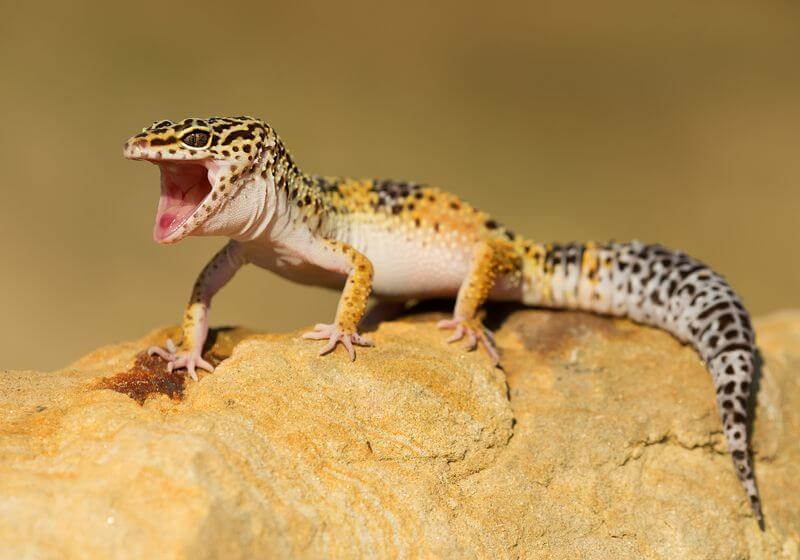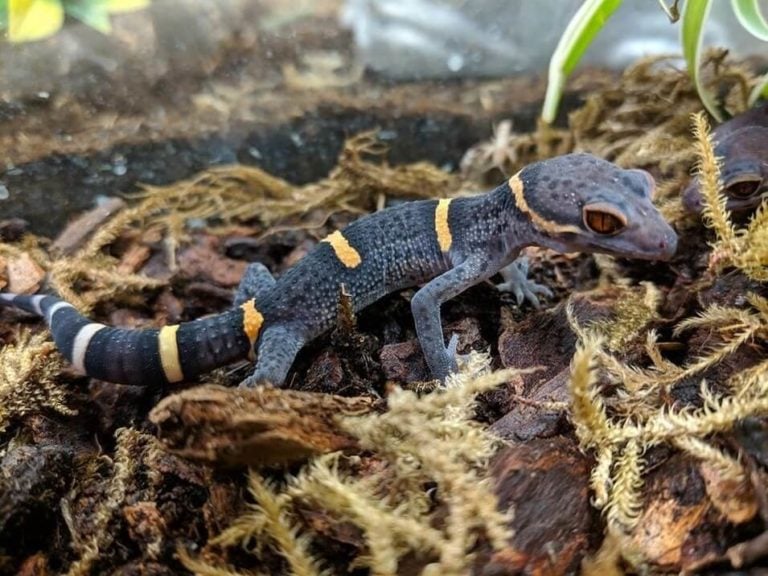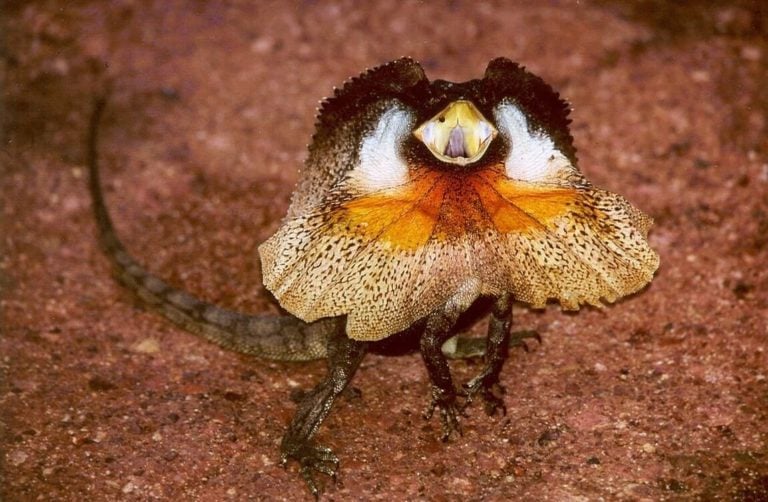Leopard gecko mouth rot is a nasty ailment that can result in serious health complications for your little pet. So if you’re an owner, understanding this infection (and what to do about it) is crucial!
This guide will teach you about mouth rot in leopard geckos, and give you a playbook for identifying and treating it.
Table of Contents
What Is Leopard Gecko Mouth Rot?
Mouth rot is an infection that causes the tissue lining a leopard gecko’s mouth to become inflamed and irritated. It’s also referred to as canker or infectious stomatitis.
This condition can affect leopard geckos at any point in their life, and there are many potential causes. In most cases, it’s a secondary infection. That means it’s a byproduct of another health issue in your gecko’s body. When the body is fighting other health issues, the immune system cannot support the delicate balance of bacteria in the mouth.
That results in infection and a myriad of other complications.
It’s not caused by a specific pathogen. Instead, mouth rot usually occurs when the existing bacteria in your leopard gecko’s mouth proliferates.
Mouth rot is a contagious condition. While the infection won’t spread to humans or other pets, it can and will affect other reptiles in the same enclosure. For that reason, it’s crucial to take extra precautions. Leopard geckos with mouth rot must be quarantined and cared for with separate equipment to minimize the spread of bacteria.
Health Complications It Can Cause
Mouth rot sounds like a superficial bacterial infection, but it can quickly spiral out of control. Failing to identify the signs of leopard gecko mouth rot and address them can lead to severe complications.
In advanced cases of mouth rot, the infection can spread to the teeth and jaw. Not only will your leopard gecko lose teeth, but their entire head can swell up to the point of causing debilitating pain. Their vision will suffer, and some infections can destroy the eye entirely. When that happens, the only treatment is total eye removal.
Mouth rot can also spread throughout the rest of the body. The infection can get into the bones, negatively impact muscles, and more. It’s common for some leopard geckos to require amputations if the disease progresses too much.
Eventually, untreated mouth rot can shut down critical biological functions in a leopard gecko. The digestive system can shut down, making it difficult for these lizards to stay healthy. Their weight can drop as their body condition suffers.
Even the respiratory system can suffer, resulting in death.
While this condition is relatively common, mouth rot is not something you should take lightly since it can be fatal. But even when it’s not, the effects of the infection can follow your leopard gecko throughout its life.
Symptoms
There are many symptoms of mouth rot in leopard geckos. What your pet experiences will depend on the severity of the infection, but here are some of the most common signs to look out for.
Excessive Drooling
Drooling is one of the first symptoms reptile enthusiasts notice. Leopard geckos are messy, but they usually have a good grip on saliva production.
When drooling occurs, it usually means something is wrong in their mouth. They might not close their mouth entirely due to pain, resulting in a steady stream of drool dripping from the mouth.
Tissue Inflammation
If you don’t notice the drooling, you’ll likely see the swelling. When bacterial infections occur, the immune system sends a swath of cells to the area. It’s an attempt to fight the infection, but the physical result is swelling.
The tissue in the mouth usually turns red if your leopard gecko has mouth rot. You’ll likely notice the swelling most around the teeth and gumline.
Bleeding
Bleeding can happen when the mouth rot has been going on for some time. The inflammation causes the skin to get ultra-sensitive and even develop sores. As a result, the flesh becomes more prone to injuries and bleeding.
Pus Discharge
Here’s one of the nastier symptoms of leopard gecko mouth rot. Pus can develop in the swollen tissue. It’s a mix of harmful bacteria getting flushed out of the system and cells sent to fight the infection. Either way, a foul discharge usually indicates a severe infection.
Pus accumulates when the infection has a strong presence in the mouth. At this point, it has likely already spread and poses a serious health risk for your leopard gecko.
Tooth Discoloration
As mentioned earlier, mouth rot infections can spread to the teeth. When they do, the bacteria will cause the teeth to rot. That usually manifests itself as black-colored spots.
Think of them as cavities. Your leopard gecko is suffering from dental decay.
Behavioral Changes
Finally, your leopard gecko will likely exhibit some strange behavioral changes. Mouth rot is a painful condition that takes its toll on these lizards.
It may cause your gecko to become lethargic. They may also stop eating because it’s too painful to eat the way they normally do. Depending on the location of the rot, they may favor one side of the mouth while avoiding all physical contact with the other.
The Cause of Mouth Rot in Leopard Geckos
There are many potential causes of mouth rot in leopard geckos. Here’s a quick breakdown of some of the most common.
1. Cuts Or Injuries In The Area
Small cuts and abrasive injuries inside your leopard gecko’s mouth provide an entry point for bacteria to get into their system. How do these injuries occur? In most cases, it’s from the live food you provide.
That doesn’t mean you should stop feeding live insects. Leopard geckos need those bugs for sustenance and nutrition.
The best thing you can do is focus on insects that are “softer.” Tough exoskeletons can cut your pet’s mouth as they crunch down. It’s also wise to swap out your substrate with something less rugged. Hard rocks and gravel can end up in your gecko’s mouth when they chase down insects.
2. Insufficient Diet
Dietary problems are another common issue. As mentioned earlier, mouth rot usually acts as a secondary infection that takes hold whenever the immune system isn’t strong enough to keep that delicate microbiome in check.
Poor nutrition weakens your gecko’s entire body. They need a nutrient-rich diet to keep their immune strength strong and capable of fighting off infections like mouth rot.
Always feed your leopard gecko protein-rich insects with supplement powders. Those supplements are vital to ensuring that your gecko gets everything they need to stay healthy.
3. Suboptimal Habitat Setup
Keeping your leopard gecko’s habitat conditions just right should always be a top priority. These reptiles need to live in simulated environments that mimic what they’re used to in the wild. That means the correct temperature, proper humidity levels, and natural lighting.
When those environmental factors are off, your leopard gecko will encounter many health problems. Mouth rot is just one of them!
Incorrect humidity levels are a common culprit. Invest in a hygrometer and use misting systems to keep things stable. The same goes for temperature gradients. There should be a consistently hot basking spot and a cooler spot that allows for proper thermoregulation.
Expert Tip: Don’t forget about the lights. These animals are nocturnal, but they need a regular day/night cycle with UVB exposure to stay healthy.
4. Lack Of Vitamin A
Vitamin A is a crucial nutrient that leopard geckos need. Deficiencies can cause abnormal growth in the oral glands, paving the way for infections like mouth rot. The glands and saliva ducts can swell, allowing bacteria to accumulate and overgrow.
Mouth rot comes after, posing ongoing health problems for your pet. Invest in Vitamin A supplement powder to dust feeder insects. Don’t hesitate to contact your vet to ensure that your lizard is getting enough.
5. Hygiene
If you don’t maintain a clean habitat for your leopard gecko, infections like mouth rot are far more likely to occur. Your lizard can’t live in its own filth, but even spot cleaning isn’t enough.
Bacteria accumulate in the environment, and parasites can try to invade your leopard gecko’s body. Pair that with tons of germs and mites, and it’s a disaster waiting to happen.
Clean the enclosure every few weeks. Don’t just spot clean. Go in with a reptile-safe disinfectant to keep bacteria at bay.
Wipe up any messes that occur, and do what you can to keep the habitat as clean as possible.
6. General Poor Care
This one is broad, but poor general care can lead to mouth rot in a number of ways. Lackluster care refers to an accumulation of bad habits on your end. Perhaps you skimp on the diet, forget to clean the habitat for several months, or don’t stay on top of environmental conditions.
If you don’t provide your leopard gecko with excellent care, a variety of health problems will come up. Mouth rot may not occur at first, but the risks of infections skyrocket whenever your geckos suffer in other ways.
They need a strong immune system to keep the bacteria in their mouths in check. When the immune system has to focus on fighting off other illnesses, it can’t keep up with the demand. As a result, your leopard gecko becomes exponentially more susceptible to mouth rot.
How To Treat It
Leopard gecko mouth rot usually starts with minor symptoms, but it quickly graduates to something potentially life-threatening if left untreated. Time is of the essence, and you can’t ignore the symptoms.
Fortunately, there are many ways to treat mouth rot.
At home, you can use a DIY solution that contains one cup of water and one teaspoon of salt. Boil distilled water, add the salt, and allow the mixture to cool completely. Then, use it regularly to clean the mouth.
Reptile-safe antiseptic solutions also serve the same purpose. You can usually find them at pet stores or vet offices.
The most effective way to treat mouth rot in leopard geckos is through a course of antibiotics. Vets will typically prescribe these medications as topical creams or pills.
As your leopard gecko recovers, make sure to quarantine them from other reptiles and clean out their enclosure. Disinfect everything to kill bacteria and prevent the condition from worsening.
Treatment takes time, but the earlier you start, the better. Catching mouth rot early will allow you to administer treatment before it turns into something deadly.
Tips For Preventing Mouth Rot In The Future
The key to preventing mouth rot is to be vigilant about your leopard gecko’s health and well-being.
It’s a good idea to reassess everything about the care you provide, starting with food. Consult with your vet to determine that you’re offering a nutrient-rich diet that meets your lizard’s needs.
Invest in supplement powder, protein-rich insects that don’t harm the mouth, and more.
Once you sort out your leopard gecko’s diet, move on to their enclosure. Purchase monitoring equipment to keep temperature, humidity levels, and lighting where they should be. Check those environmental conditions regularly, and you can easily avoid infections and stress.
Finally, adopt a regular tank maintenance schedule. Perform deep cleaning of the enclosure to minimize bacterial spread.
Good husbandry can make a huge difference. Go the extra mile to take care of your leopard gecko, and mouth rot will not be an issue moving forward.
When To Visit Your Veterinarian
The best time to visit a vet is whenever you spot the signs of mouth rot!
This condition is serious and can spiral out of control. Cleaning the mouth with antiseptic or salt solutions can buy you time. However, you need veterinary intervention for strong medications like antibiotics.
Those medications are easily misused, so it’s wise to have a vet’s guidance. A vet will also determine if your leopard gecko has mouth rot or if they’re dealing with some other condition. They can also rule out any underlying health issues you must address to bring your lizard good health.
Closing Thoughts
Leopard gecko mouth rot isn’t something to fear if you provide your lizard with excellent care. But still, it’s always worth knowing what it looks like in case bad luck strikes!
If you think your leopard gecko might be suffering from mouth rot, contact your vet ASAP. They’ll be able to diagnose the problem and put your little pet on the path to recovery.



